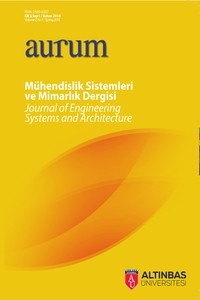Implementation of Different Clustering Algorithms/Farklı Sınıflandırma Algoritmalarının Uygulamaları
Sınıflandırma, K-ortalama, Spektral metod, Laplace, Özdeğer vektör, GUI
Implementation of Different Clustering Algorithms/Farklı Sınıflandırma Algoritmalarının Uygulamaları
Clustering, K-means, Spectral method, Laplace, Eigenvector, GUI,
___
- S. Sharma, “Applied Multivariate Techniques,” John Willey Sons, 1996.
- [H. Tatlıdil, “Uygulamalı çok değişkenli istatistiksel analiz,” Akad. Yayınları, 1996.
- Q. Li, Y. Ren, L. Li, and W. Liu, “Fuzzy based af fi nity learning for spectral clustering,” Pattern Recognit., vol. 60, pp. 531–542, 2016.
- I. B. Society, “A General Coefficient of Similarity and Some of Its Properties Author ( s ): J . C . Gower Published by : International Biometric Society Stable URL : http://www.jstor.org/stable/2528823 International Biometric Society is collaborating with JSTOR to digitize , preserve and extend,” vol. 27, no. 4, pp. 857–871, 2018.
- F. H. C. Guttiérrez Toscano, P.,& Marriott, “Unsupervised classification of chemical compounds. Journal of the Royal Statistical Society,” Ser. C (Applied Stat., vol. 48, no. 2, pp. 153–163, 1999.
- C. Hair Jr, J. F., Anderson, R. E., Tatham, R. L., & William, “Multivariate data analysis with readings.,” New Jersy Prentice Hall., 1995.
- M. R. Anderberg, “Cluster analysis for applications: probability and mathematical statistics: a series of monographs and textbooks.,” Acad. Press, vol. 19, 2014.
- M. S. Blashfield, R. K.,& Aldenderfer, “The literature on cluster analysis. Multivariate Behavioral Research,” vol. 13, no. 3, pp. 271–295, 1978.
- S. H. Spielmat, D. A.,& Teng, “Spectral partitioning works: Planar graphs and finite element meshes.,” Found. Comput. Sci. Proceedings., 37th Annu. Symp. IEEE., pp. 96–105, 1996.
- M. Everitt, B. S., Landau, S., & Leese, “Clustering analysis,” Arnold, London, 2001.
- M. Han, J., Pei, J., & Kamber, Data mining: concepts and techniques. Elsevier, 2011.
- A. Ş. Çelik, M., Dadaşer-Çelik, F., & Dokuz, “Anomaly detection in temperature data using dbscan algorithm.,” Innov. Intell. Syst. Appl. (INISTA), 2011 Int. Symp. IEEE, pp. 91–95.
- M. Ester, H. Kriegel, X. Xu, and D.- Miinchen, “A Density-Based Algorithm for Discovering Clusters in Large Spatial Databases with Noise,” 1996.
- H. (Eds. ). Ho, T. B., Cheung, D., & Liu, “Advances in Knowledge Discovery and Data Mining,” in 9th Pacific- Asia Conference, PAKDD 2005, Hanoi, Vietnam, May 18-20, 2005, Proceedings(Vol. 3518). Springer., 2005.
- G. Yazgan, E.,& KAYAALP, “Kümeleme (Cluster) Analizi Yöntemlerinin Karşılaştırmalı Olarak İncelenmesi ve Tarımsal Araştırmalarda Kullanılması.,” Zootekni Anabilim Dalı, Adana., 2002.
- R. Atkinson, Q., Nicholls, G., Welch, D., & Gray, “From words to dates: water into wine, mathemagic or phylogenetic inference?,” Trans. Philol. Soc., vol. 103, no. 2, pp. 193–219, 2005.
- A. Kannan, R., Vempala, S., & Vetta, “On clusterings: Good, bad and spectral,” J. ACM (JACM), 51(3), 497- 515., 2004.
- F. H. C. Marriott, “Practical Problems in a Method of Cluster Analysis,” Biometrics, vol. 27, no. 3, pp. 501– 514, 1971.
- https://www.mathworks.com/matlabcentral/fileexchange/34412-fast-and-efficient-spectral-clustering
- ISSN: 2564-6397
- Yayın Aralığı: Yılda 2 Sayı
- Başlangıç: 2017
- Yayıncı: Altınbaş Üniversitesi
POLIGON MODELLEME İLE ÖYKÜ OLUŞTURMA
UYDU VERILERINE DAYALI OLARAK BITKI ÖRTÜSÜ ANALIZI
Nagihan ESENDAL BOZKURT, Metin ZONTUL, Zafer ASLAN
TÜRKIYE’YE ÖZGÜ BITKI VE GIDA ÖRNEKLERININ TEMEL BILEŞENLER ANALIZIYLE SINIFLANDIRILMASI
MATLAB, PHYTON VEYA R KULLANARAK WEB TABANLI BÜYÜK MOLEKÜLER VERI DÖNÜŞÜM ANALIZI
Implementation of Different Clustering Algorithms/Farklı Sınıflandırma Algoritmalarının Uygulamaları
Amna Mohamed M. ABURAS, Wamidh MAZHER, Osman Nuri UÇAN, Oğuz BAYAT
ÖNCÜL BILGI TABANLI KAN PAYLAŞIM SISTEMI TASARIM VE UYGULAMASI
Tayfun ÇELİK, Oğuz BAYAT, Adil Deniz DURU, Osman Nuri UÇAN
